
A SENSE of inevitability about a lumpy skin disease incursion is emerging, with cattle producers and industry leaders now drawing attention to the need to ensure protocols for trade continuity where the appetite exists with customers.
The hope is to follow in the footsteps of other livestock industries where zoning arrangements have been negotiated which allow, in the event of an outbreak, exports to continue from non-affected regions.
An African swine fever pre-emptive zoning arrangement was formalised between Australia and its largest pig meat export market, Singapore.
Concern has been expressed that the hysteria around foot and mouth disease may have distracted from the focus that needs to be on lumpy skin, which would be just as devastating for the cattle industry and has a significantly higher risk assessment of reaching Australia.
Lumpy skin is in Indonesia's northern island of Sumatra and there is a vaccination program underway in an attempt to contain it. However, the virus has the ability to spread via biting insects, such as flies, mosquitos and ticks, and as such could literally 'blow in' to northern Australia via monsoonal weather.
Australian Government modelling on the long distance dispersal of insects via tropical storms from southern Indonesian islands demonstrated that a large region of northern Australia was susceptible to the incursion of infected insects.
The risk assessment of the likelihood of a lumpy skin incursion into Australia in the next five years is estimated at a 28 per cent chance, significantly higher than the 11.6pc chance of incursion given to FMD, said Matt Dalgleish,Thomas Elder Markets.
Northern Territory Livestock Exporters Association chairman David Warriner said the odds of lumpy skin getting into Australia's herds by insect transmission on the northern monsoon winds was now very real.
ALSO IN BEEF:
Producers have urged the continuation of behind-the-scenes work by industry leaders and the government to ensure trade disruptions are minimised in the event of a lumpy skin incursion.
NTLEA chief executive officer Tom Dawkins said where ever possible and where there's appetite with our trading partners, Australia needs to be on the front foot because there was certainly a sense of 'when' not 'if' in terms of a lumpy skin disease incursion.
"If, by the time that incursion eventuates, we haven't got in place protocols for trade continuity, Australian producers will surrender market share to our competitors and we know that the longer it takes to renegotiate exports, the harder it will be to wrestle back that footprint," he said.
"In the case of any trade suspension of live cattle to a country like Indonesia triggered by LSD, the harder it will be for the feedlots and abattoirs who buy Australian cattle to remain in business.
"The prospect of seeing our live cattle supply chains wither while we wait for who knows how long for trade terms to be renegotiated is very scary. Just as frightening is the prospect of more Indian buffalo meat or South American beef filling the protein void and heightening the risks of further FMD outbreaks on our doorstep in Indonesia."
JBS feedlot livestock manager Jason Carswell agreed the biggest concern now was negotiation on health certificates around both lumpy skin and FMD.
"We enjoy fairly free access to most of the world, the big concern will be how we get access back in if we do have an incursion," he said.
"Some countries will be more fickle than others but I stress our NLRS (National Livestock Reporting Service) is one of best traceability systems in the world and that will get us back on track as fast as possible."
Australian Meat Industry Council chief executive officer Patrick Hutchinson said discussions were happening with all Australia's red meat markets.
"It's a two-way dialogue on what the risk is and how we will manage it and it is about instilling in our customers confidence in our systems," he said.
"We are the world's most trusted and reliable supplier of red meat and people want us in their markets, not out of them."


